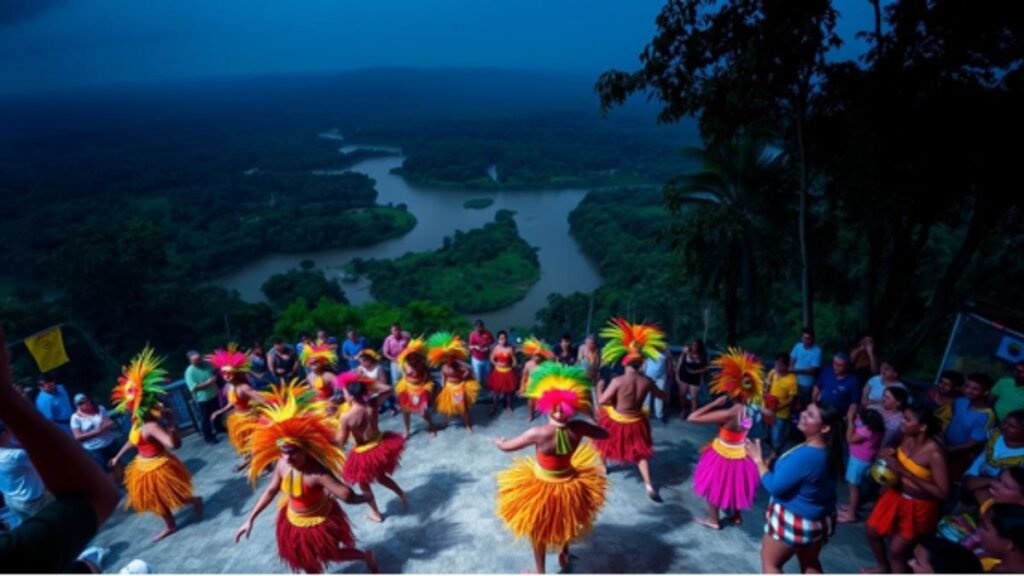Introduction
What if the most thrilling celebration in Brazil isn’t in Rio or Salvador? Hidden in the heart of the Amazon, the Parintins Festival —a dazzling event —takes place every year, blending tradition, rivalry, and spectacle into something truly unforgettable.
This vibrant festival showcases the rich cultural tapestry of the region, featuring intricate performances that tell stories of folklore and local legends. Each year, thousands gather to witness the intense competition between teams, known as “boi-bumbá,” where they passionately depict their narratives through music, dance, and elaborate floats, creating an atmosphere charged with excitement and community spirit.

Since 1965, this cultural gem has captivated thousands. Recognized by UNESCO, it offers an intimate yet electrifying experience unlike any other. While bigger carnivals draw millions, this one thrives on authenticity and deep-rooted heritage, showcasing the vibrant spirit of the Amazonian people.
Attendees are not just spectators; they become part of a living tapestry of stories and traditions that echo through the years, making each festival a unique moment in time. The atmosphere is charged with a sense of community, where friendships are forged, and cultural pride is celebrated.
Set on an island in the Amazon River, the celebration brings the city to life with vibrant costumes, fierce team competitions, and a connection to local culture that’s hard to match. The colorful displays of artistry and creativity reflect the rich folklore of the region, and the sounds of traditional music resonate through the air, inviting everyone to join in the festivities. Ready to discover why it stands out?
Key Takeaways
- Held annually in late June, with 2024 dates set for June 28-30.
- Recognized as Brazilian Cultural Heritage by UNESCO.
- Draws 35,000+ spectators for a more immersive experience.
- Features unique team rivalries and breathtaking visuals.
- Takes place on Tupinambarana Island in the Amazon.
The Cultural Heartbeat of the Parintins Festival
Deep in the Amazon, a cultural explosion blends ancient traditions with modern energy. This event pulses with stories passed down for generations, where myth and reality collide under the jungle canopy. The vibrant atmosphere is not just a spectacle; it is a testament to the resilience and creativity of the local communities, showcasing their deep-rooted connection to the land and its stories. As the sun sets, the festival grounds come alive, drawing in both locals and visitors who are eager to witness this unique celebration of life and culture.
A Celebration Rooted in Amazonian Folklore
At its heart, the celebration honors the legend of the Bumba Meu Boi. The tale follows Father Francisco and Mother Catirina, whose resurrected ox symbolizes the interconnectedness of all beings and the cyclical nature of life. Each performance weaves this folklore into 2.5-hour spectacles of music and dance, where elaborate costumes and intricate choreography bring the story to life.
The performers embody the characters with passion, creating an immersive experience that captivates the audience and invites them to participate in the rich narrative of their heritage.
The Legend of Bumba Meu Boi
More than a story, it’s a bridge to pre-colonial Tupi-Guarani rituals, serving as a vital link between past and present. The 2024 theme, “Cultura – O Triunfo do Povo”, highlights indigenous empowerment and the resilience of cultural identities. This theme resonates deeply within the community, reminding everyone of their roots and the importance of preserving their heritage.
The legend itself serves not only as entertainment but also as a profound reminder of the struggles and triumphs faced by indigenous peoples throughout history. Even the language—nheengatu, derived from the Tupi people—keeps history alive, acting as a vessel for stories and traditions that have been passed down through generations. It plays a crucial role in cultural preservation, allowing new generations to connect with their ancestry and understand the narratives that shaped their identity.
As communities come together to celebrate this vibrant folklore, they reaffirm their commitment to cultural continuity and the revitalization of their languages, which are essential to maintaining the rich tapestry of their heritage.
Indigenous and Contemporary Fusion
Traditional marujada percussion meets electronic beats, creating a vibrant soundscape that reflects the evolution of Brazilian music. Costumes, which incorporate feathers and tree bark, symbolize the deep connection to nature and the environment that is central to indigenous beliefs.
Since 2000, IPHAN has recognized this mix as Brazilian Cultural Heritage, emphasizing its significance in the national identity. Here, the past isn’t remembered—it’s relived, as each performance draws audiences into a celebration that honors both history and innovation.
The Thrilling Rivalry: Caprichoso vs. Garantido
Two teams, two colors, one unforgettable showdown—this is the essence of Brazil’s most unique competition. Since 1966, the clash between Caprichoso (blue star) and Garantido (red heart) has transformed the city into a vibrant canvas of passion and tradition, where the rivalry intensifies every year, drawing thousands to witness the spectacle.
The competition is not merely about winning; it’s a demonstration of community spirit and pride, where each team represents the heart and soul of their supporters, embodying the cultural narratives that define their existence.
Red vs. Blue: A Color-Coded Competition
Loyalties run deep here. Fans *never* wear the rival’s color or even speak the opposing team’s name. The Bumbódromo stadium splits into vibrant zones: one side a sea of blue, the other a blaze of red. This division is not merely aesthetic; it symbolizes the fierce pride and identity each team instills in its supporters.
The atmosphere is electric, filled with chants, songs, and the rhythmic beating of drums, as fans passionately rally behind their colors. Every performance is a showcase of not just talent but also the emotional investment of the community, where each cheer and every tear reflects a shared history and commitment to their team.
The rivalry is a celebration of cultural heritage, transforming the stadium into a living tapestry of devotion and rivalry, with each side determined to outshine the other in this annual spectacle.

Even global brands adapt. Coca-Cola releases half-red, half-blue cans to stay neutral, reflecting the intense loyalty and passion that the rivalry ignites among fans. Such adaptations underscore the cultural significance of this competition, where even global corporations acknowledge the deeply rooted traditions and sentiments associated with the Caprichoso and Garantido teams.
The 2024 champions, Caprichoso, won with their theme “Cultura – O Triunfo do Povo.” Still, the rivalry remains razor-thin, with each year bringing fresh themes and creative expressions that resonate with the community’s identity and pride.
| Stat | Caprichoso | Garantido |
|---|---|---|
| Total Wins (58 years) | 29 | 26 |
| 2024 Score | 392.5 | 387.3 |
| Signature Color | Blue | Red |
The Rules of the Showdown
This isn’t just a performance, it’s a competition with strict rules that ensure fairness and excitement. Each team gets 150 minutes to impress judges with their artistry and creativity, showcasing the best of their cultural heritage and innovation:
- Choreography (40% of score).
- Live music (30%)—modern instruments are banned to preserve traditional sounds.
- Costumes (20%)—handmade from feathers, bark, and beads, reflecting the local environment and artistry.
- Timing (10%)—exceeding limits means penalties, adding to the pressure of the performance.
How Fans Fuel the Festivity
The people make this rivalry legendary. In 2024, a 92-minute standing ovation broke records, showcasing the unwavering support and enthusiasm of the fans. This remarkable display of appreciation not only highlighted the dedication of the spectators but also served as a testament to the passion that fuels this annual event.
Fans coordinate chants, wave LED lights, and follow unspoken rules that amplify the atmosphere, creating a sense of unity and excitement that reverberates throughout the arena:
For three days, the Amazon pulses with this electric experience, creating a unique blend of competition and camaraderie. The vibrant energy of the crowd transforms the event into something far greater than just a contest; it becomes a shared journey that connects individuals from all walks of life.
It’s not just a battle; it’s a celebration of identity, where every cheer adds another line to history, uniting the community in a shared narrative of pride and passion. This collective spirit is what makes the festival a cherished tradition, as families and friends come together to witness and participate in this extraordinary cultural phenomenon.
A Visual Spectacle Unlike Any Other
Under the Amazonian stars, an arena comes alive with colors and rhythms unlike any other. The air is thick with anticipation, as vibrant hues dance across the stage, reflecting the energy of the crowd. Each pulse of the music resonates through the very ground, creating a palpable connection between the performers and the audience.
This place transforms into a stage where tradition and innovation collide, creating an experience that lingers long after the final curtain falls. The atmosphere is electric, with cheers and gasps intertwining as the audience becomes a part of the spectacle, their emotions ebbing and flowing with every act. Each performance captivates the audience, drawing them into a world where every note and movement tells a story, leaving an indelible mark on their hearts and minds.
It’s a moment of unity, where strangers become friends, bound by the shared thrill of the show, and the memories created here will echo in their lives for years to come.

The Bumbódromo: A Stage for Legends
Designed by an Oscar Niemeyer protégé, the bull-shaped Bumbódromo is a marvel of modern architecture and cultural significance. Its unique design, reminiscent of a majestic bull, captures the spirit of the festival, symbolizing strength and unity.
The 360° stage and bull-horn lighting rig ensure every seat has a perfect view, allowing spectators to immerse themselves fully in the vibrant performances. In 2024, a record 38,000 people packed the arena nightly, braving the Amazon heat, each person contributing to an electric atmosphere that reverberated with excitement and anticipation.
Costumes, Floats, and Dazzling Performances
Each year, 18 tons of ethically sourced feathers adorn handcrafted costumes, showcasing the incredible artistry and dedication of the designers. Dancers wear pieces with 3,200+ sequins, reflecting light like the Amazon River at sunset, creating a mesmerizing spectacle that enchants the audience.
The intricate designs are not only visually stunning but also tell stories of cultural heritage and pride. The 2024 floats reached an impressive 40 feet, with animated LED oxen stealing the show, their vibrant colors and movements captivating all who witnessed the parade.
Each float is a masterpiece, meticulously crafted to embody the festival’s themes, blending tradition with innovation in a celebration of creativity.
| Element | Details | Eco-Friendly Practices |
|---|---|---|
| Costumes | Hand-sewn, biodegradable materials | Feathers from managed sources |
| Floats | LED-lit, reusable frames | River cleanup initiatives |
| Prep Time | 14 months per team | Natural dyes |
Music That Echoes the Amazon
The music here serves as a bridge between the past and present, intertwining the sounds of the Amazon with contemporary influences. Curimbó drums and bamboo flutes blend with modern harmonies during the six-month composition process, creating a unique soundscape that resonates deeply with both locals and visitors alike. As one performer noted:
“Our toadas aren’t just songs—they’re stories of the forest, each note carrying the weight of our history and the essence of our land.”
For three days, the air thrums with rhythms as old as the Amazon River itself, echoing the heartbeat of the jungle and the spirits of its inhabitants. It’s a dance of sound and time, where every note honors the place it calls home, reflecting the community’s struggles and triumphs.
This celebration of music not only entertains but also educates, fostering a deep appreciation for the cultural heritage that defines the Amazon.
Why Parintins Outshines Rio and Salvador’s Carnivals
While Brazil’s famous carnivals draw global attention, a lesser-known event in the Amazon offers something deeper and more profound. It’s not just about flashy parades and extravagant costumes; it’s a celebration rooted in tradition, community, and raw authenticity, where every participant plays a vital role in the narrative being told through music and dance.
The Parintins festival encapsulates the spirit of the Amazon, showcasing local folklore and the rich tapestry of stories that have been passed down through generations. Each performance is a heartfelt tribute to the land and its people, emphasizing the connection between the performers and their cultural heritage.
Intimacy Over Tourist Crowds
Rio’s carnival packs 2.7 people per square meter. Here, it’s just 1.3, giving space to breathe and connect. This spaciousness fosters a more intimate atmosphere, allowing attendees to engage with one another and the vibrant culture surrounding them.
With 98% local participation, visitors experience the region’s soul, not just a tourist spectacle, allowing for genuine interactions and a shared sense of belonging that transcends mere observation. The festival becomes a living tapestry of community spirit, where every laugh, dance, and song resonates with the essence of the Amazon, creating lasting memories that echo far beyond the event itself.
Families pass down roles for generations, creating a lineage of participation that strengthens community bonds. Artisans craft costumes in backyards, not factories, using traditional techniques and locally sourced materials that reflect their heritage. This craftsmanship adds depth to the festival, making each costume a story in itself. As one attendee noted:
“It’s like being welcomed into someone’s home rather than watching a show.” This sentiment captures the heart of the experience, where the lines between performer and audience blur, inviting everyone to partake in the celebration of culture and tradition.
Cultural Roots vs. Commercial Glitz
Where Salvador’s carnival relies on $12M in sponsorships, this city funds its festival through community “vaquinhas” (collective donations), which fosters a deep sense of ownership and pride among the locals. The result? A focus on heritage, not profits, allows the festival to flourish organically, rooted in the traditions and values of the community.
| Feature | Amazonian Event | Rio Carnival |
|---|---|---|
| Indigenous Rituals | 159 documented | 12 samba schools |
| Materials | Biodegradable confetti | Plastic waste |
| Local Businesses | 85% family-owned | Chain-dominated |
A Community’s Heartbeat
72% of visitors return each year, a testament to its emotional pull and the unique experiences that keep them coming back. Unlike impersonal mega-festivals, this experience connects people to Brazil’s living culture through shared stories, vibrant interactions, and a palpable sense of community that resonates with everyone involved.
From handmade costumes to eco-conscious floats, every detail reflects the Amazon’s spirit, showcasing local artistry and sustainable practices. Here, celebration isn’t performed, it’s lived, creating lasting memories and fostering connections that extend beyond the festival itself.
Conclusion
Beyond the glitter of big-city carnivals lies a cultural treasure. This place blends UNESCO-recognized heritage, fierce rivalries, and eco-conscious spectacles into an unmatched experience. With 35% of people attending now international, its authenticity speaks louder than crowds.
Mark your calendar for June 27–29, 2025, the 60th anniversary promises record-breaking energy. Book 6–12 months ahead to secure your time in the Amazon’s heart.
Ready to trade commercialized events for living culture? The festival awaits. Learn more Manaus.
FAQ
When does the event take place each year?
The celebration happens annually in late June, transforming the city into a vibrant hub of music, dance, and folklore.
What makes this competition unique compared to other Brazilian festivals?
Unlike Rio’s Carnival, this event focuses on deep-rooted Amazonian traditions, with two rival teams telling a legendary tale through stunning performances.
How do the teams express their rivalry?
Caprichoso (blue) and Garantido (red) compete through elaborate floats, costumes, and music, each aiming to outshine the other in a fierce yet artistic showdown.
What role does the Bumbódromo play in the event?
This massive arena hosts the performances, allowing thousands to witness the dazzling spectacle of dance, lights, and storytelling under one roof.
Why is the festival considered more authentic than Rio’s Carnival?
It prioritizes indigenous culture and community spirit over commercial appeal, offering an immersive experience tied to the Amazon River’s heritage.
Can visitors participate, or is it just for spectators?
While the main competition is team-driven, attendees join the celebration through dances, singing, and embracing the electrifying energy of the rivalry.




